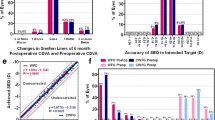Abstract
To evaluate the postoperative higher-order aberration (HOA) differences and visual quality outcomes of wavefront-optimised photorefractive keratectomy (PRK) surgery in 6.5-mm and 7.0-mm optic zones. The study included 136 eyes of 68 patients who underwent wavefront-optimised PRK surgery for myopia or myopia with astigmatism. Q values, third-order coma (Z [3, 1] and Z [3, − 1]), third-order trefoil (Z [3] and Z [3, − 3]), fourth-order spherical aberration (Z [4, 0]) and aberration coefficients were evaluated before surgery and 6 months after surgery. All patients underwent ophthalmic examinations that included visual acuity, central corneal thickness and intraocular pressure. The mean age of participants was 25.5 ± 6.7 (18–50 years). A total of 38 (55.88%) participants were male and 30 (44.12%) were female. In half of the eyes (n = 68), the 6.5-mm optic zone was selected (group 1), while the 7.0-mm optic zone was selected for other half (n = 68; group 2). No statistically significant difference was observed between the two groups in terms of preoperative best corrected visual acuity (BCVA) and postoperative uncorrected visual acuity (UCVA) (p = 0.45 and p = 0.22, respectively). The 7.0-mm optical zone was found to be associated with lower aberration coefficient values and lower Z [4, 0] spherical aberrations of HOAs. Although the 6.5-mm optical zone was associated with an increase in most wavefront aberration variables, measurements were not statistically different between two groups other than aberration coefficients and Z [4, 0] spherical aberrations. Photorefractive keratectomy performed with both the 6.5-mm and 7.0-mm optical zone diameters is very successful in correcting refractive errors. For some HOAs, treatment with the 7.0-mm optical zone seems to be more advantageous.

Similar content being viewed by others
References
Sharma M, Wachler BS, Chan CC (2007) Higher order aberrations and relative risk of symptoms after LASIK. J Refract Surg 23(3):252–256
Martinez CE, Applegate RA, Klyce SD, McDonald MB, Medina JP, Howland HC (1998) Effect of pupillary dilation on corneal optical aberrations after photorefractive keratectomy. Arch Ophthalmol 116(8):1053–1062
Oshika T, Klyce SD, Applegate RA, Howland HC, El Danasoury MA (1999) Comparison of corneal wavefront aberrations after photorefractive keratectomy and laser in situ keratomileusis. Am J Ophthalmol 127(1):1–7
Jahadi Hosseini SH, Abtahi SM, Khalili MR (2016) Comparison of higher order aberrations after wavefront-guided LASIK and PRK: one year follow-up results. J Ophthalmic Vis Res 11(4):350–357
Carones F, Brancato R, Morico A, Venturi E, Gobbi PG (1996) Evaluation of three different approaches to perform excimer laser photorefractive keratectomy for myopia. Ophthalmic Surg Lasers 27(5 Suppl):S458–S465
Endl MJ, Martinez CE, Klyce SD, McDonald MB, Coorpender SJ, Applegate RA et al (2001) Effect of larger ablation zone and transition zone on corneal optical aberrations after photorefractive keratectomy. Arch Ophthalmol 119(8):1159–1164
Almahmoud T, Munger R, Jackson WB (2011) Effects of advanced surface ablations and intralase femtosecond LASIK on higher order aberrations and visual acuity outcome. Saudi J Ophthalmol 25(3):275–280
Moreno-Barriuso E, Lloves JM, Marcos S, Navarro R, Llorente L, Barbero S (2001) Ocular aberrations before and after myopic corneal refractive surgery: LASIK-induced changes measured with laser ray tracing. Invest Ophthalmol Vis Sci 42(6):1396–1403
Mrochen M, Kaemmerer M, Mierdel P, Seiler T (2001) Increased higher-order optical aberrations after laser refractive surgery: a problem of subclinical decentration. J Cataract Refract Surg 27(3):362–369
Seo KY, Lee JB, Kang JJ, Lee ES, Kim EK (2004) Comparison of higher-order aberrations after LASEK with a 6.0 mm ablation zone and a 6.5 mm ablation zone with blend zone. J Cataract Refract Surg 30(3):653–657
Author information
Authors and Affiliations
Corresponding author
Ethics declarations
Competing interests
The authors declare that they have no conflict of interest.
Additional information
Publisher’s note
Springer Nature remains neutral with regard to jurisdictional claims in published maps and institutional affiliations.
Rights and permissions
About this article
Cite this article
Ozulken, K., Gokce, S.E. Evaluation of the effect of optic zone diameter selection on high-order aberrations in photorefractive keratectomy excimer laser treatment. Lasers Med Sci 35, 1543–1547 (2020). https://doi.org/10.1007/s10103-020-02948-w
Received:
Accepted:
Published:
Issue Date:
DOI: https://doi.org/10.1007/s10103-020-02948-w




